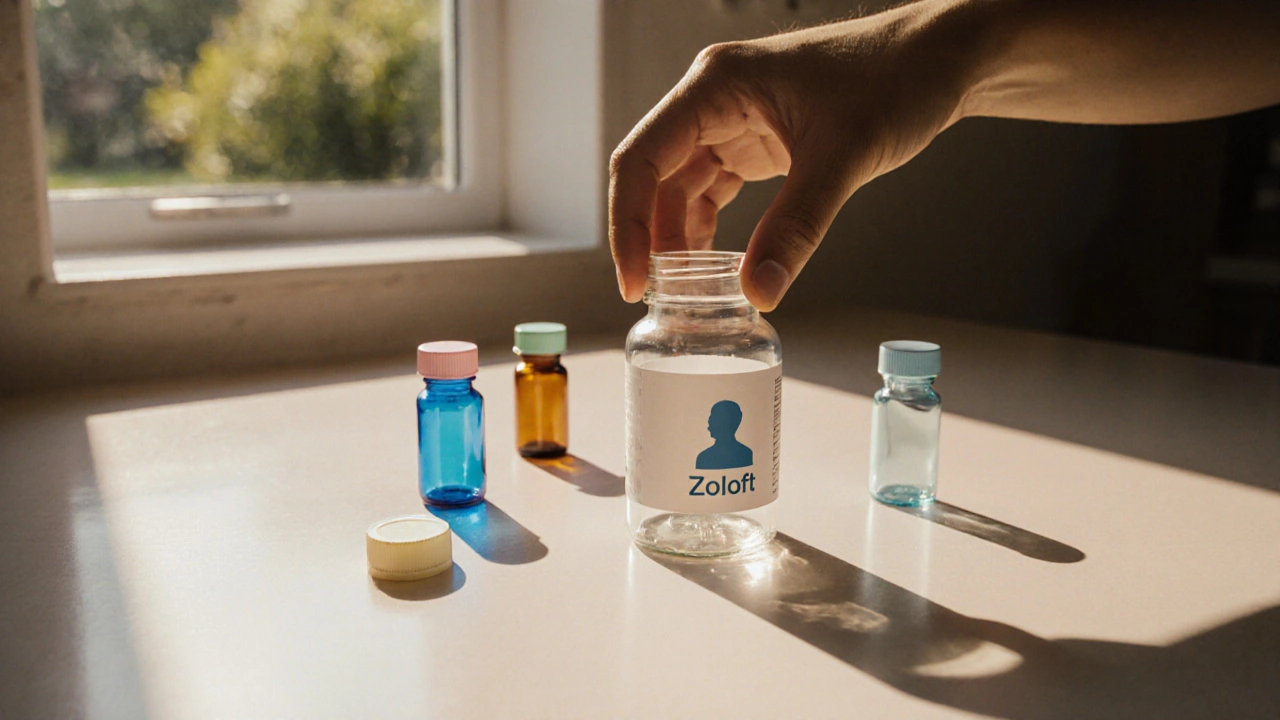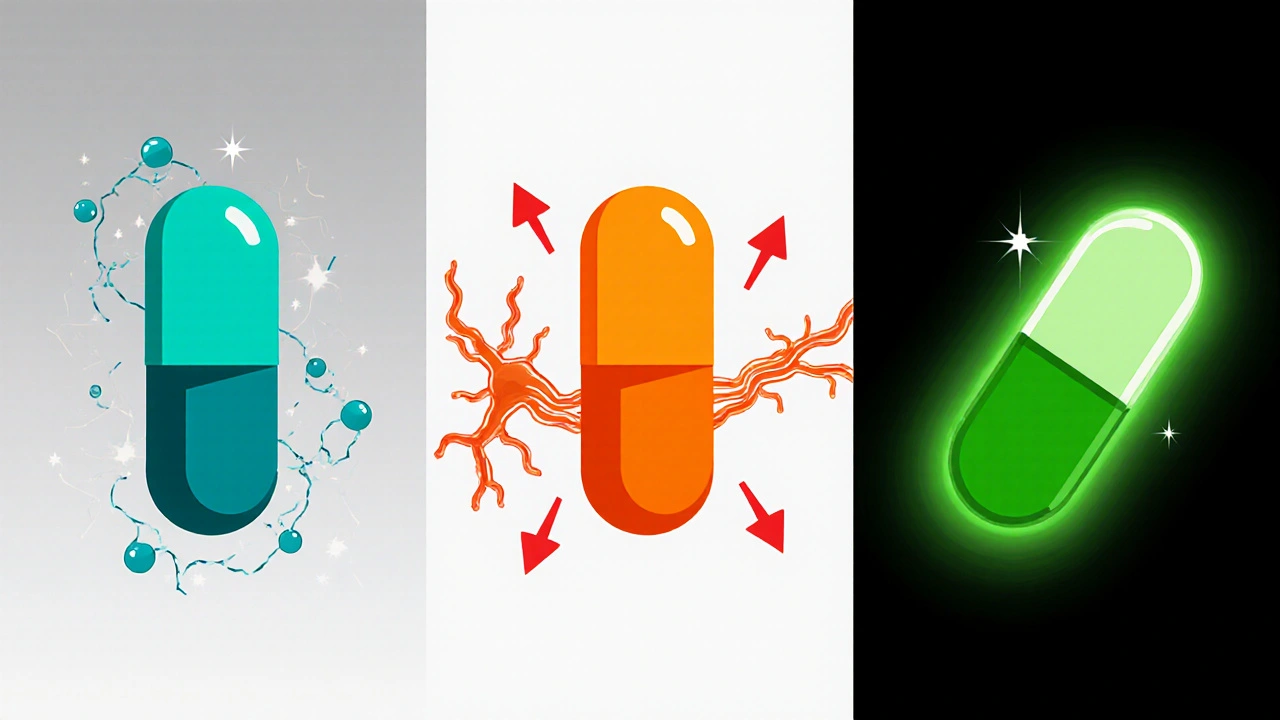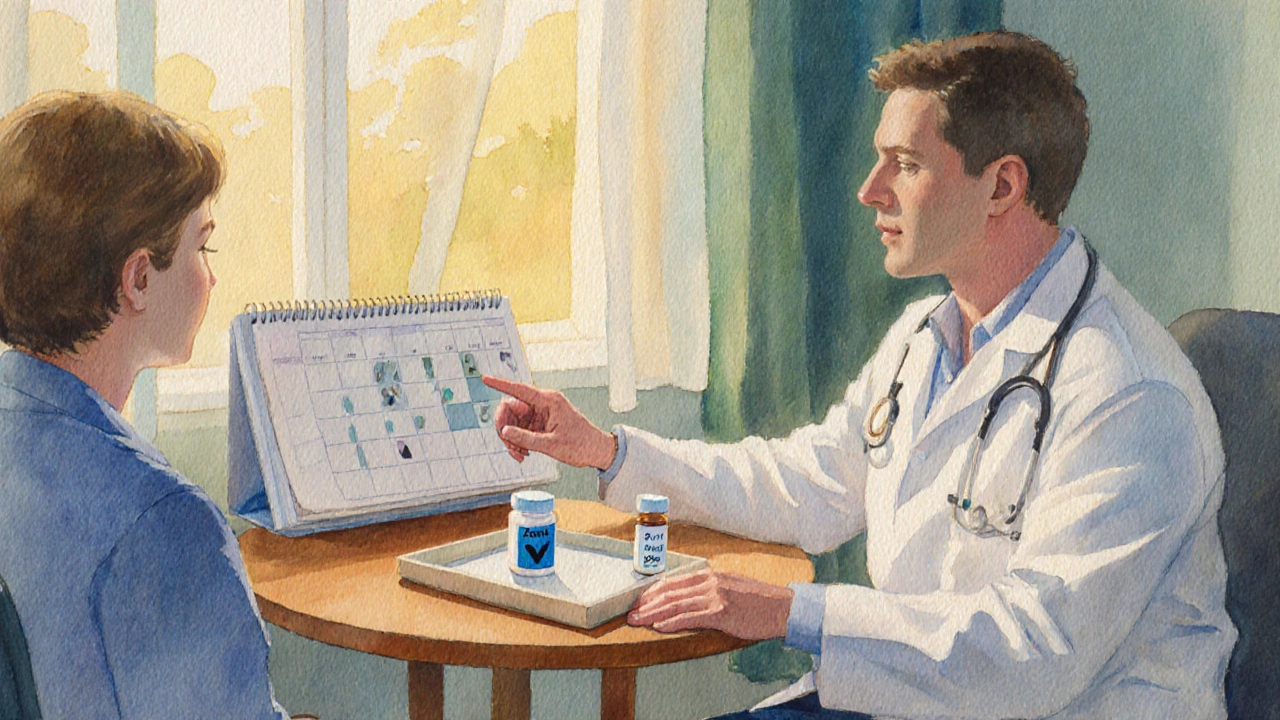Zoloft (Sertraline) vs Top Antidepressant Alternatives - 2025 Comparison

Antidepressant Side Effect Comparison Tool
Your Priority Concerns
Select what side effects matter most to you. The tool will recommend alternatives based on your priorities.
Your Personalized Recommendations
Top Recommendations
Why These Recommendations?
Comparison Summary
| Medication | Sexual Dysfunction | Weight Change | Insomnia | Blood Pressure |
|---|
Looking for a medication that works better than your current Zoloft prescription? You’re not alone. Millions of people wonder whether another antidepressant might give them fewer side‑effects, a quicker mood lift, or a better fit for their health profile. This guide breaks down the most common Sertraline alternatives, compares how they stack up against Zoloft, and gives you a clear checklist for choosing the right option.
Key Takeaways
- Sertraline (Zoloft) is an SSRI with a long safety record, but it can cause sexual dysfunction, weight changes, and insomnia for some users.
- Escitalopram and fluoxetine are the closest SSRI cousins, often offering similar efficacy with a slightly different side‑effect profile.
- Venlafaxine and duloxetine are SNRI choices that add pain‑relief benefits but may raise blood pressure.
- Bupropion works via dopamine‑norepinephrine pathways, making it a good fit for patients who struggle with sexual side‑effects.
- Choosing the right antidepressant hinges on diagnosis, co‑existing conditions, drug interactions, and personal tolerance to side‑effects.
What Is Sertraline?
Sertraline is a selective serotonin reuptake inhibitor (SSRI) approved by the FDA in 1991 for major depressive disorder, obsessive‑compulsive disorder, panic disorder, social anxiety, post‑traumatic stress disorder, and premenstrual dysphoric disorder. By blocking the serotonin transporter, it increases serotonin levels in the brain, which helps elevate mood and reduce anxiety. Typical adult dosing starts at 50mg once daily, with a half‑life of about 26hours, allowing steady plasma levels with once‑daily dosing.
How to Pick an Antidepressant
Finding a better match isn’t about “one‑size‑fits‑all.” Consider these five decision points:
- Primary symptom focus: Pure depression, anxiety, pain, or a mix?
- Side‑effect tolerance: Are sexual dysfunction, weight gain, or insomnia deal‑breakers?
- Medical history: Heart disease, hypertension, bipolar disorder, or substance use?
- Drug interactions: Current meds, especially blood thinners, antipsychotics, or other serotonergic drugs.
- Cost and access: Insurance coverage, generic availability, and pharmacy convenience.
With these factors in mind, let’s look at the most popular alternatives.

Top Alternatives to Sertraline
The following drugs are the most frequently prescribed when clinicians or patients decide to switch from Zoloft.
- Escitalopram - A newer SSRI (approved 2002) known for a slightly cleaner side‑effect profile, especially less daytime drowsiness.
- Fluoxetine - The original SSRI (Prozac) with a long half‑life (4-6 days), useful for patients who miss doses.
- Paroxetine - An SSRI that’s potent but often linked to withdrawal symptoms, so tapering is crucial.
- Venlafaxine - An SNRI that adds norepinephrine reuptake inhibition, helping with chronic pain and severe anxiety.
- Duloxetine - Another SNRI especially effective for neuropathic pain and diabetic peripheral neuropathy.
- Bupropion - A norepinephrine‑dopamine reuptake inhibitor (NDRI) that rarely causes sexual side‑effects and can aid smoking cessation.
- Mirtazapine - An atypical antidepressant that stimulates appetite and improves sleep, useful for patients with weight loss or insomnia.
- Duloxetine - Listed again for emphasis on its dual action on serotonin and norepinephrine, giving it an edge for comorbid pain conditions.
Side‑Effect Snapshot
Below is a quick look at the most common side‑effects for each drug, based on large‑scale clinical trials and post‑marketing data.
| Medication | Sexual Dysfunction | Weight Change | Insomnia/Day‑time Drowsiness | Blood Pressure Impact |
|---|---|---|---|---|
| Sertraline | 30% | ±2% gain/loss | 15% insomnia | Neutral |
| Escitalopram | 25% | ±1% gain | 10% insomnia | Neutral |
| Fluoxetine | 20% | ±1% loss | 20% insomnia | Neutral |
| Paroxetine | 35% | ±3% gain | 12% drowsiness | Neutral |
| Venlafaxine | 18% | ±2% gain | 14% insomnia | ↑5mmHg (dose>150mg) |
| Duloxetine | 22% | ±2% gain | 13% insomnia | ↑4mmHg (dose>120mg) |
| Bupropion | 5% | ±1% loss | 10% insomnia | Neutral |
| Mirtazapine | 10% | ↑4% gain | 5% drowsiness | Neutral |
When Each Alternative Shines
Escitalopram - Best for patients who need a mild SSRI with fewer sleep disturbances. Works well for generalized anxiety disorder.
Fluoxetine - Ideal for individuals who struggle with medication adherence, thanks to its long half‑life that smooths out missed doses.
Paroxetine - Often chosen for panic disorder because of its strong serotonergic effect, but plan a gradual taper to avoid withdrawal.
Venlafaxine - The go‑to when depression co‑exists with chronic pain (e.g., fibromyalgia) or severe anxiety that hasn’t responded to an SSRI.
Duloxetine - Similar to venlafaxine but with more evidence for diabetic neuropathy and osteoarthritis pain relief.
Bupropion - Perfect for patients who experience sexual side‑effects on SSRIs or want to quit smoking; also helps with seasonal affective disorder.
Mirtazapine - Helpful for patients with insomnia or loss of appetite; its sedative effect can be a benefit at night.

Cost & Accessibility in 2025
All the drugs listed are available as generics in North America, keeping out‑of‑pocket costs low (usually under $20 per month). Insurance formularies often prefer generics, so check your plan’s tier. Venlafaxine extended‑release (Effexor XR) and duloxetine (Cymbalta) can be slightly pricier than older SSRIs, but patient assistance programs exist.
Switching Safely from Sertraline
Never stop sertraline abruptly-it can trigger discontinuation syndrome (dizziness, “brain zaps,” anxiety). Follow these steps:
- Discuss the switch with your prescriber; they’ll set a taper schedule (e.g., reduce 25mg every 1-2 weeks).
- Start the new medication at a low dose while still on the tapering sertraline.
- Monitor for overlapping side‑effects (e.g., increased serotonin syndrome risk if both are serotonergic).
- Schedule a follow‑up within 2‑4 weeks to evaluate efficacy and tolerability.
Frequently Asked Questions
Can I take an SSRI and an SNRI together?
Combining two serotonergic agents increases the risk of serotonin syndrome, a potentially life‑threatening condition. Doctors usually avoid this combo unless there’s close monitoring and a clear clinical justification.
How long does it take to feel better after switching?
Most antidepressants need 4-6 weeks to reach full effect. When switching, you might notice mood changes within the first 1-2 weeks as your brain adjusts, but give the new drug at least a month before judging overall success.
Are there natural alternatives to sertraline?
Exercise, cognitive‑behavioral therapy (CBT), and omega‑3 supplementation can complement medication, but they rarely replace it for moderate‑to‑severe depression. Always discuss any “natural” approach with your clinician.
What if I gain weight on sertraline?
Weight gain is reported in ~5‑10% of users. Switching to bupropion or mirtazapine (if weight loss is needed) can help; however, mirtazapine often causes weight gain, so choose based on your overall health goals.
Is it safe to use sertraline during pregnancy?
Sertraline is classified as Category C in the US, meaning risk cannot be ruled out. Many obstetricians continue it when depression severity outweighs potential fetal risk, but discuss alternatives like escitalopram if you’re concerned.
Bottom Line
Sertraline remains a solid first‑line choice for many mood and anxiety disorders, but it’s not the only game in town. By weighing your symptom profile, side‑effect tolerance, and any co‑existing health issues, you can pinpoint a drug that feels like a better fit-whether that’s a cleaner SSRI like escitalopram, a pain‑focused SNRI such as duloxetine, or an atypical option like bupropion that sidesteps sexual dysfunction. Always partner with your healthcare provider for a safe taper and personalized plan.
Taryn Bader
October 14, 2025 AT 14:14Zoloft can feel like a roller coaster, and you’re not alone when the side effects start to weigh you down.
Myra Aguirre
October 19, 2025 AT 05:21I hear you, the sexual side‑effects are a real hassle for many.
Shawn Towner
October 23, 2025 AT 20:27While the guide paints most SSRIs with the same brush, the pharmacodynamic nuances between sertraline and escitalopram actually merit a more granular discussion.
Ujjwal prakash
October 28, 2025 AT 10:34Indeed, the subtle differences in receptor affinity, half‑life, and metabolic pathways can translate into clinically meaningful outcomes; for example, escitalopram’s higher selectivity for the 5‑HT1A receptor often results in fewer sexual side‑effects, yet sertraline’s broader spectrum can be advantageous for comorbid anxiety; furthermore, individual pharmacogenomics-especially CYP2C19 and CYP2D6 polymorphisms-play a decisive role in serum concentrations; patients who are poor metabolizers may experience exaggerated side‑effects on sertraline, whereas extensive metabolizers might tolerate it well; this is why therapeutic drug monitoring, though not routine, can be a valuable tool; also, the impact on sleep architecture differs, with sertraline sometimes worsening insomnia due to its mild activating properties; conversely, escitalopram is generally neutral regarding sleep; the weight‑gain profile is also distinct, as sertraline carries a modest risk of weight increase, whereas escitalopram is essentially weight neutral; finally, clinicians should weigh these pharmacological subtleties against patient‑reported outcomes and preferences before defaulting to a one‑size‑fits‑all approach.
Cindy Knox
November 2, 2025 AT 01:41Your roadmap to a smoother mood journey should start with an honest look at what your body tolerates.
beverly judge
November 6, 2025 AT 16:47When evaluating alternatives, consider the specific side‑effects that bother you most; for instance, if sexual dysfunction is a deal‑breaker, bupropion is a strong candidate because it targets dopamine and norepinephrine rather than serotonin. Also, keep an eye on weight trends-mirtazapine tends to cause weight gain, while fluoxetine may lead to modest loss. Finally, don’t forget that dose titration speed can affect how quickly you notice improvements or side‑effects, so work with your prescriber to find the sweet spot.
Capt Jack Sparrow
November 11, 2025 AT 07:54Fact: sertraline’s half‑life means steady plasma levels, but if you miss a dose, the rebound can feel like a crash.
Jesse Groenendaal
November 15, 2025 AT 23:01Skipping the taper is just reckless.
Persephone McNair
November 20, 2025 AT 14:07From a neuropharmacological standpoint, the serotonergic reuptake inhibition profile of Zoloft distinguishes it from the norepinephrine‑centric action of SNRIs, which explains its comparatively neutral impact on blood pressure.
siddharth singh
November 25, 2025 AT 05:14Let me break it down step by step, because the nuances matter when you’re deciding whether to stay on sertraline or switch. First, the serotonin reuptake inhibition of Zoloft is strong but not as selective as escitalopram, which can lead to a slightly higher incidence of sexual side‑effects; that 30 % figure you see in the table isn’t a random number, it comes from large‑scale meta‑analyses. Second, weight change with sertraline is modest-usually a 2–3 % fluctuation-so for patients worried about gaining pounds, bupropion or fluoxetine may be preferable, as they tend toward weight loss or neutrality. Third, insomnia is reported in about 15 % of users, and that’s often linked to sertraline’s mild activating effect; if nighttime rest is a priority, consider mirtazapine, which is sedating, or an SNRI like duloxetine that has a more balanced sleep profile. Fourth, blood pressure impact is essentially neutral for sertraline, unlike venlafaxine or duloxetine, which can raise systolic pressure at higher doses; this makes sertraline a safer option for patients with borderline hypertension. Fifth, the half‑life of roughly 26 hours means steady state is reached in about a week, providing stable coverage, but also means that discontinuation symptoms can appear faster if you stop abruptly. Sixth, drug‑drug interactions are relatively few with sertraline, but it does inhibit CYP2D6, so watch out for medications metabolized by that pathway, such as certain beta‑blockers or antipsychotics. Seventh, the cost factor is usually low because generic sertraline is widely covered by insurers, which is a practical consideration for long‑term therapy. Eighth, the risk of serotonin syndrome is low when sertraline is used alone, but combining it with another serotonergic agent-like tramadol or St. John’s wort-can raise that risk, so you need to be vigilant. Ninth, the genetic variability in CYP2C19 and CYP2D6 means some patients will metabolize sertraline faster or slower, influencing both efficacy and side‑effect burden; pharmacogenetic testing can be useful here. Tenth, for patients with comorbid anxiety disorders, sertraline’s anxiolytic properties are well‑documented and often more robust than those of some other SSRIs. Eleventh, if you’re dealing with chronic pain, an SNRI such as duloxetine might give you dual benefit, whereas sertraline lacks significant analgesic effects. Twelfth, the withdrawal syndrome-sometimes called discontinuation syndrome-can include dizziness, “brain zaps,” and flu‑like symptoms; tapering slowly over weeks is essential. Thirteenth, some clinicians report that sertraline works faster for mood elevation than other SSRIs, though the evidence is mixed. Fourteenth, adherence is easier with once‑daily dosing, and sertraline’s flexible dosing (25‑200 mg) allows clinicians to fine‑tune the effect. Fifteenth, the overall safety profile remains favorable, with serious adverse events being rare. Finally, the decision should be personalized: weigh the side‑effect profile you’re most sensitive to against the therapeutic benefits you need, and involve your prescriber in a shared decision‑making process.
Angela Green
November 29, 2025 AT 20:21Please note the correct spelling of “sertraline” and ensure commas separate clauses appropriately.
April Malley
December 4, 2025 AT 11:27Indeed, proper punctuation clarifies the comparison; for example, weight gain is reported at ≈2 %, while sexual dysfunction hovers around 30 %.
scott bradshaw
December 9, 2025 AT 02:34Only true patriots stick with the tried‑and‑true.
Crystal Price
December 13, 2025 AT 17:41Your sarcasm just proves why many patients switch off the pill.
Murhari Patil
December 18, 2025 AT 08:47Did you ever wonder why the pharma giants keep pushing Zoloft despite its side‑effects?